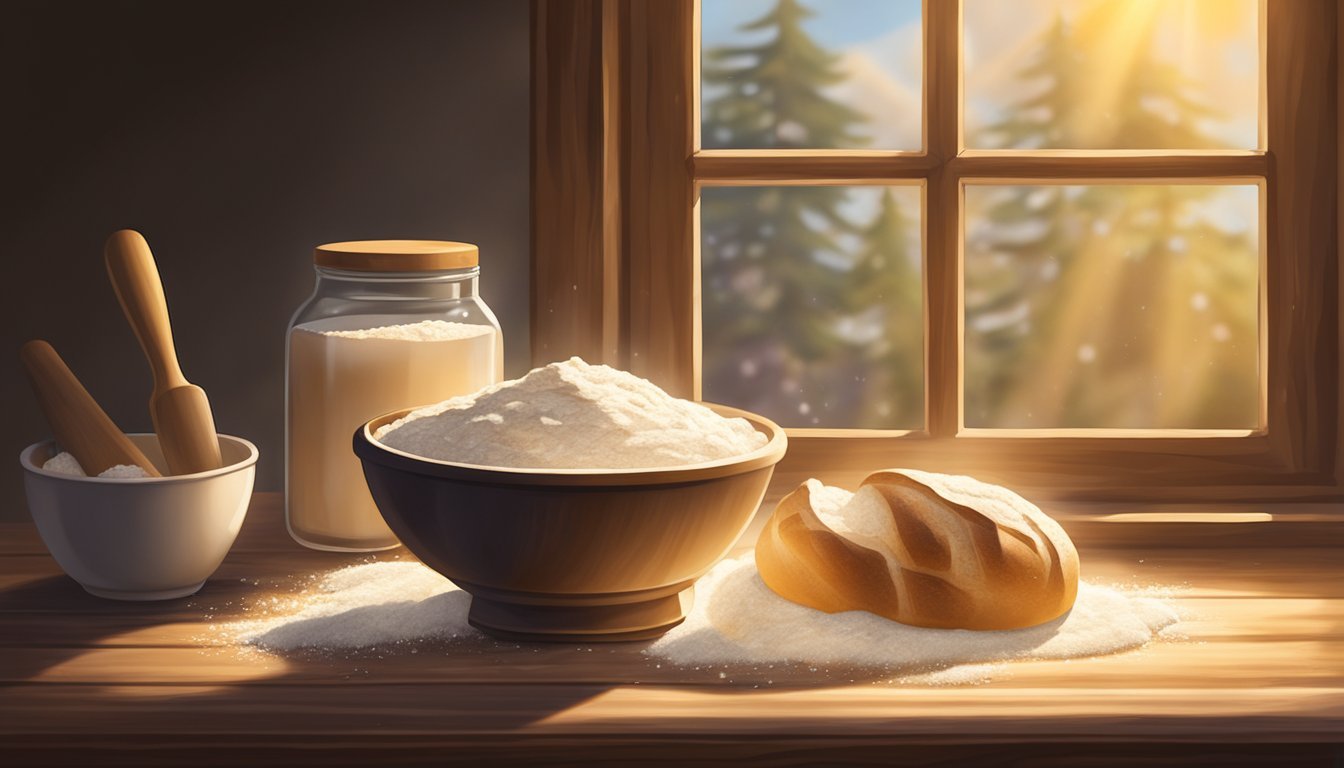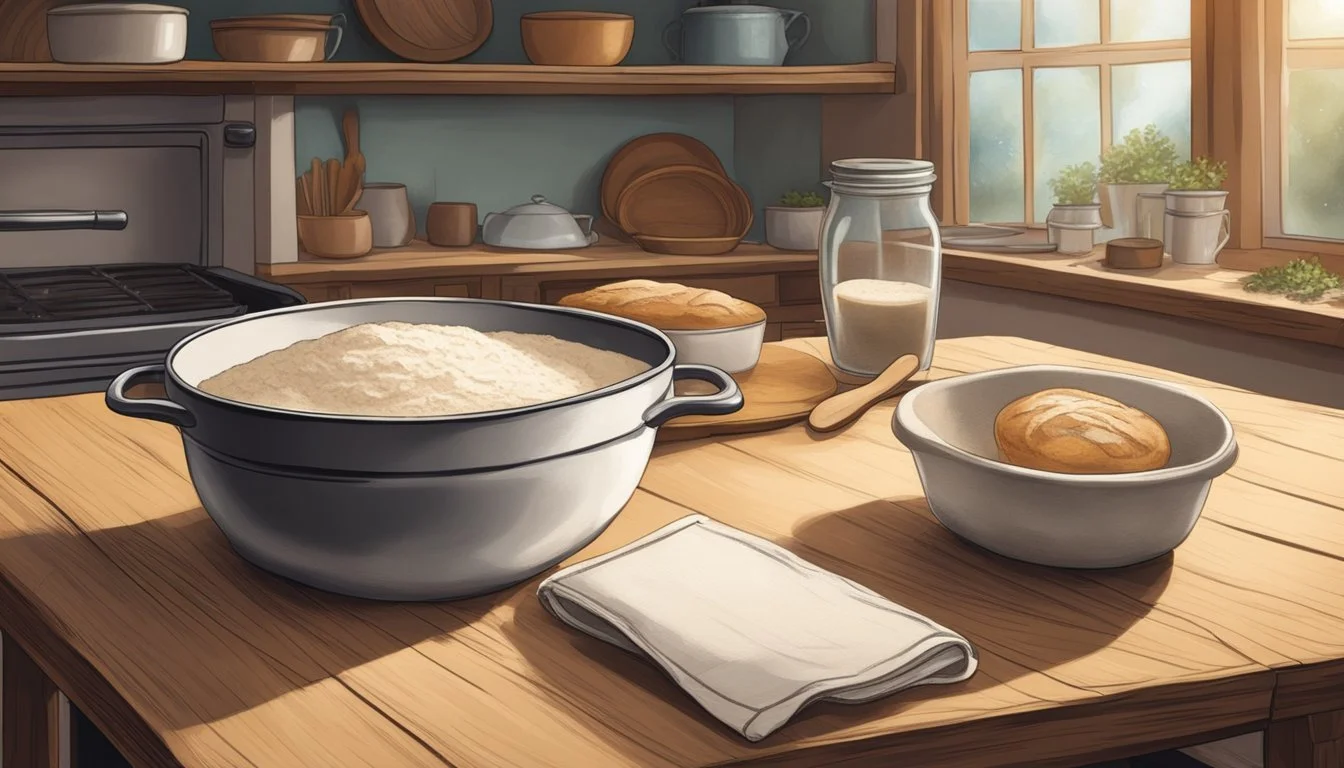Sourdough Baking as Mindfulness Practice
Cultivating Patience and Presence
Sourdough baking is more than just a culinary craft; it is increasingly recognized as a form of mindfulness practice. Mindfulness involves maintaining a moment-by-moment awareness of our thoughts, feelings, bodily sensations, and the surrounding environment. The process of creating sourdough, with its slow fermentation and hands-on techniques, naturally encourages individuals to slow down and engage fully with the task at hand. This engagement in sourdough making can facilitate a state of present-moment awareness, which has been linked to reduced stress and improved mental clarity.
The intricate steps of sourdough baking require attention to detail, from mixing the simple ingredients to the precise timing of fermentation. This attentiveness to the sensory experiences of sourdough crafting—the smell of the fermenting dough, the feel of the flour, the sound of the crust cracking—allows bakers to immerse themselves in the process. Such an immersive activity can serve as a grounding experience, promoting calmness and reducing anxiety. The repetitive motions of kneading the dough are particularly meditative, helping to create a rhythm that can keep the baker focused and in a mindful state.
Moreover, the practice of baking sourdough bread (What wine goes well with bread?) encourages patience and acceptance. Each step from starter cultivation to the final bake requires a level of surrender to the variables outside one's control, such as temperature and humidity. Bakers learn to adapt to the dough's needs, adjusting their techniques with a mindful approach, and developing an understanding that perfection is less important than the act of creation. The result is not just a loaf of bread, but an experience that nurtures mental well-being and a sense of accomplishment.
The Sourdough Journey
Embarking on the sourdough journey offers an opportunity to explore the traditions of bread making while nurturing mental well-being through the practice of mindfulness.
History and Resurgence
Sourdough bread, one of the oldest forms of grain fermentation, has been a staple in human diets for centuries. It's believed that sourdough starter—a mixture of flour, water, and wild yeast—was used by ancient civilizations, evolving into the nuanced craft it is today. The recent resurgence of sourdough baking can be significantly attributed to the COVID-19 pandemic, where lockdowns gave rise to a revival of home baking. During this period, many sought comfort in the ritualistic process of creating sourdough, leading to a newfound appreciation for its artisanal qualities and the sense of accomplishment from nurturing a batch from starter to loaf.
Understanding Sourdough
Sourdough's distinctiveness lies in its fermentation process, where the sourdough starter acts as a natural leavening agent. The starter is a live culture composed of wild yeasts and lactic acid bacteria, requiring regular feeding of flour and water to maintain its health and activity. The fermentation stage is crucial—the yeast consumes the sugars in the dough, producing gas and alcohols, which cause the bread to rise and develop a complex flavor profile. Unlike commercially produced bread, sourdough is made without added yeast, relying on its fermentation to impart a tangy flavor and improve bread texture.
Components of a Sourdough Starter:
Flour: Provides nutrients for yeast and bacteria
Water: Hydrates the flour, aiding fermentation
Wild Yeast: Naturally present in flour, ferments sugars
Lactic Acid Bacteria: Produces acids, contributing to the tangy flavor
The lengthy, hands-on nature of sourdough baking encourages mindfulness, a psychological process of being present and fully engaged in the moment, which can have therapeutic benefits. It challenges bakers to become attuned to the subtleties of the dough's development, fostering a connection with the food they create.
Sourdough Baking as Meditation
Sourdough baking offers a unique opportunity to engage in meditation through a hands-on process. The act of baking requires concentration and presence, making it an effective mindfulness practice. It combines the tactile experience of kneading with the patience needed for the dough to rise, fostering a meditative state.
Mindfulness in Kneading
The act of kneading dough is more than just a step in the baking process; it is an opportunity for mindfulness. Bakers often describe kneading as a time when they can focus solely on the texture and transformation of the dough. This single-task attention directs the baker's awareness to the present moment, which is the essence of mindfulness. The repetitive motion can serve as a grounding technique, helping to alleviate stress and encourage mental clarity.
Rhythm of Baking
Throughout the sourdough process, there is a natural rhythm that bakers fall into: mix, knead, rest, shape, and bake. Each step has its own pace, requiring different levels of engagement and attention. Bakers find tranquility in this rhythm, similar to the way one might find serenity through the repetition of a meditation mantra. This cadence encourages a mental presence that is integral to both baking and meditation.
Mental Presence in Baking
Patience is a virtue in both mindfulness practice and sourdough baking. Waiting for dough to rise is a test of patience and an exercise in letting go of control. During this time, bakers can observe the subtle changes in the dough, which encourages a deeper mental presence and connection with their work. The slow transformation of the dough mirrors the gradual shift towards mental wellness and stability that often comes with mindfulness meditation.
Ingredients and Tools
Before beginning the mindful practice of sourdough baking, one should carefully select high-quality ingredients and reliable tools. These elements serve as the foundation to achieve not only a tasteful and textured outcome but also to ensure the process remains stress-free and therapeutic.
Choosing the Right Flour
Flour, the core component of sourdough, profoundly affects the bread's taste and texture. For a robust and flavorful sourdough, one should opt for whole grain flour which provides more nutrients and a deeper flavor compared to all-purpose flour. Specialty flours like rye or spelt can further enhance the complexity of the sourdough's character.
All-Purpose Flour: Suitable for beginners for its consistent results.
Whole Wheat Flour: Offers a richer flavor and more fiber.
Rye Flour: Contributes a unique taste and denser texture.
Water: The Element of Transformation
Water serves not just to hydrate the flour but acts as the catalyst for fermentation. It is vital to use lukewarm water to initiate the sourdough starter's activity effectively. The temperature of the water is crucial as water that is too hot can kill the yeast, while water that's too cold may retard the fermentation.
Water Temperature: Aim for 75-85°F (24-29°C) to optimize yeast activation.
The Importance of Salt
Salt is essential for both flavor and the bread's structure. It tightens the dough's gluten network, improving texture, and regulates yeast activity preventing over-fermentation. Typically, about 2% salt relative to the flour weight is the standard baker's percentage for sourdough bread.
Sea Salt or Kosher Salt: Preferred for their natural and pure taste.
In terms of tools, a digital kitchen scale is indispensable for measuring ingredients accurately. Other tools include a dough scraper, proofing baskets, and a Dutch oven for even baking. Starting with essential, reliable tools can make the process more enjoyable and meditative.
The Science of Sourdough
Sourdough baking is a blend of art and precise science, marked by the intricate dance of biochemistry and physics. Unpacking the processes behind the rise and flavor of sourdough bread provides insights into this beloved craft.
Fermentation Process
Fermentation is at the heart of sourdough's unique characteristics. Sourdough fermentation involves both wild yeast and lactobacillus bacteria, which are naturally present in flour. Flour and water mixed to create a sourdough starter, serve as a culture medium where these microorganisms flourish. The fermentation process can be broken down into stages:
Lactic Acid Fermentation: Lactic acid bacteria convert sugars into lactic acid, contributing to the sour flavor.
Ethanol Fermentation: Yeast cells metabolize sugars anaerobically, producing ethanol and carbon dioxide, which help the bread rise.
The ambient temperature plays a vital role in the fermentation process, with warmer conditions accelerating the activity of lactic acid bacteria, resulting in a tangier flavor.
Role of Wild Yeast
Wild yeast, naturally found in the environment and on the grains, is a driving force in sourdough baking. Unlike commercial yeast, wild yeast strains produce a slower rise and contribute to the complex flavor profile of sourdough. They coexist with lactobacillus bacteria within the starter, and the balance between the two is crucial. Wild yeast cells are responsible for:
Converting sugars into carbon dioxide and ethanol
Aiding in dough structure and gluten network formation
Contributing to the final taste and texture of the bread
The Autolyse Method
Introduced by French baker Raymond Calvel, the autolyse method is a technique used to improve the extensibility and strength of dough. It involves a simple process:
Mix flour and water: Combine and let the mixture sit typically for 20 to 60 minutes before adding yeast and salt.
Resting period: This pause allows enzymes to break down complex carbohydrates into simpler sugars, which yeast can more easily metabolize.
The method results in a more cohesive dough exhibiting better fermentation, workability, and ultimately, a bread with a more open crumb structure and enhanced flavor. It is important to note that the autolyse method is not a fermentation stage, but a preparatory step that precedes the addition of sourdough starter.
Crafting Your Sourdough
Crafting your sourdough involves careful consideration of ingredients and techniques to create a bread that's a reflection of both your skill and attentiveness. The perfect recipe, desired texture, and the final shape of the loaf are fundamental to the art of sourdough baking.
Creating the Perfect Recipe
One begins by selecting quality flour and fresh, non-chlorinated water—these are the foundation of any sourdough recipe. A balance of white and whole grain flours can provide both structure and flavor. The proportion of water to flour, known as the hydration level, directly affects the sourdough's texture and must be precise. A baker may start with a 75% hydration for a standard balance between workability and a nice, open crumb.
Achieving the Desired Texture
The texture of sourdough bread is a tactile hallmark of its quality. To achieve a chewy interior and crusty exterior, one must maintain a consistent feeding schedule of the sourdough starter. Temperature and humidity play vital roles in the fermentation process that develops the dough's structure and flavor profile. Proper kneading and proofing are also critical. Kneading strengthens the gluten network, while proofing allows the dough to rise appropriately.
Shaping Your Loaf
After fermentation, shaping the dough is the next step in defining the final character of the sourdough bread. It begins with gently forming the dough into a round or oval shape, creating tension on the surface without tearing. The shaped dough is then typically placed into a floured banneton to hold its form and ensure an even rise. Right before baking, the baker scores the dough with a lame or sharp knife to guide the expansion and create a signature appearance.
Community and Sharing
Sourdough baking transforms a solitary activity into a conduit for community bonding and emotional fulfillment. Through the sharing of skills, creations, and experiences, individuals foster connections and cultivate joy within their social circles.
Building Connections Through Bread
The simple act of baking sourdough bread can serve as a bridge between individuals, helping to foster a sense of community and belonging. As they share their homemade loaves, bakers facilitate an exchange of more than just food – they create opportunities for connection. This act often leads to conversations, exchange of recipes, and the forming of friendships based upon mutual appreciation for the craft of baking.
Sharing the Joy of Sourdough
When a baker shares a piece of sourdough bread, they are sharing not only a culinary creation but also the joy ingrained in the process. Each loaf encapsulates the care and attention poured into its making, which inherently brings pleasure to both the giver and receiver. The act of giving bread is symbolic, often perceived as an extension of love and goodwill in many cultures.
The Gift of Teaching Sourdough
Passing on the knowledge of sourdough baking is a gift that contributes to community resilience and self-reliance. Teaching someone to bake sourdough allows them to tap into the therapeutic aspects of baking, promoting well-being while simultaneously preserving traditional baking methods. By educating others, bakers empower them with a skill that can be shared further, extending the community's capacity for joy and connection through the art of sourdough.
Personal Growth and Resilience
Sourdough baking offers a unique pathway for individuals to cultivate patience and resilience, develop intuitive skills, and find therapeutic benefits.
Developing Patience and Resilience
Sourdough baking requires time and attention to detail. The slow and attentive process necessitates a patient approach as the baker waits for the natural leavening to work. This act of waiting helps to build resilience as the baker learns to navigate the unpredictability of fermentation. With each batch, one learns that small variances in temperature or humidity can impact the dough, instilling a deeper understanding of persistence through trial and error.
Intuition and Mindful Adjustment
Intuition plays a significant role in sourdough baking. Bakers attune to the subtleties of the dough's texture, aroma, and appearance, making mindful adjustments based on their senses. This level of mindfulness during the process allows them to respond intuitively to the needs of the dough, enhancing both their baking skills and their capacity for attunement in other areas of life.
Healing and Therapy Through Baking
The repetitive motions of kneading and shaping dough can serve as a form of therapy, fostering a meditative state that can alleviate feelings of anxiety. The focused practice of sourdough baking often leads to therapeutic outcomes, as engaging one's hands and mind in the present moment provides a restorative break from the stress of daily life. The nurturing aspect of creating and sharing bread also contributes to an individual's sense of healing and well-being.
Getting Started: Practical Tips
Embarking on the journey of sourdough baking introduces a mindful practice into one's routine. Through the creation and maintenance of a sourdough starter to the final bake, the process offers a meditative experience.
Sourdough Starter 101
Creating a sourdough starter involves mixing flour and water and allowing it to ferment. This mixture should be kept in a container large enough to allow for expansion. It's vital to begin with equal parts by weight of flour and water, such as 4 ounces of each. The mixture should be kept in a warm environment, around 70°F (21°C), and you'll need to "feed" it daily with fresh flour and water to keep the yeast active and healthy.
Essential Baking Guidance
They should follow a few key steps for a successful sourdough baking experience:
Measure ingredients accurately: Precision is essential, so use a kitchen scale.
Mind the temperature: The dough should be kept at a consistent, warm temperature for optimal rising.
Kneading: The process should be rhythmic and can act as a stress-reliever, transforming it into a fun and therapeutic activity.
Timing: Patience is necessary—do not rush the fermentation and proofing stages.
Bake: Once the dough has risen and shaped, baking will finalize the transformation from simple ingredients to a beautiful, artisanal loaf.
Maintaining Your Starter
To maintain a healthy sourdough starter, the baker should adhere to a regular feeding schedule, adding equal parts flour and water each day or once a week if refrigerated. It's important to discard a portion of the starter before each feeding to keep it from becoming overly acidic and to encourage the growth of yeasts and bacteria. The starter should have a pleasant, tangy aroma and should bubble regularly, indicating it's ready for baking.
Sourdough in the Digital Age
In an era where technology permeates every aspect of life, sourdough baking finds a unique position. It offers a tangible, hands-on experience that contrasts with the digital landscapes we navigate daily. Yet, even this ancient practice has been influenced by the digital age, through the formation of online communities, content creation, and the curation of subscription lists.
Online Sourdough Communities
Online forums and social media platforms have cultivated extensive sourdough communities. These digital congregations bring together enthusiasts from different corners of the world, creating spaces where they can share knowledge, troubleshooting tips, and encouragement. Platforms like Instagram, Facebook, and specialized forums are full of sourdough bakers who demonstrate the diversity and reach of these communities.
Facebook Groups: Members can post images, seek advice, and participate in events.
Instagram Hashtags: Bakers use hashtags like #SourdoughSunday to showcase their creations and connect with others in the sourdough space.
Creating and Sharing Content
The act of creating and sharing content is central to sourdough baking in the digital age. Bakers document their journey from starter to finished loaf, presenting a plethora of videos, blogs, and step-by-step guides. This content not only helps beginners but also serves as a source of inspiration and knowledge for the more experienced.
Tutorials: Detailed guides for each step of the sourdough baking process.
Time-lapse Videos: Capturing the rise and bake of the bread, popular on YouTube.
Subscription and Email Lists
Subscription services and curated email lists serve as essential tools for keeping enthusiasts updated. They provide recipes, troubleshooting guides, and information on the latest trends in sourdough baking, directly to the subscriber's inbox.
Recipe Sharing: Subscribers receive new and tested sourdough recipes.
Newsletter Updates: Information on the latest tools and techniques in the world of sourdough.










